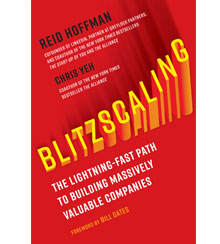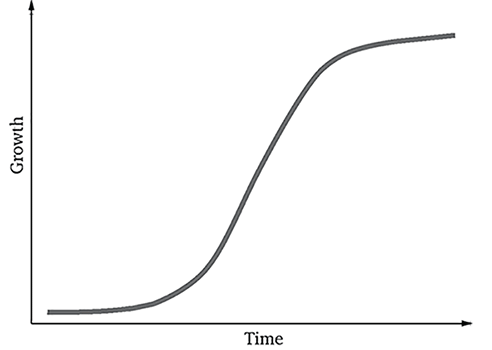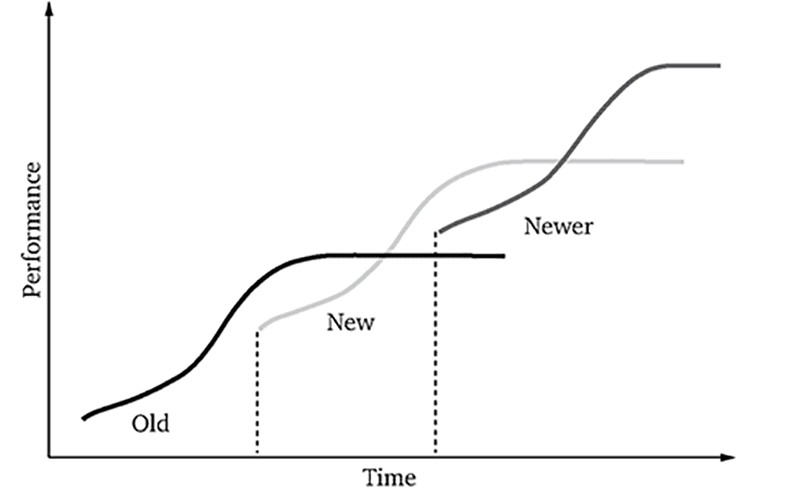The Blitzscaling Basics
In their new book, Reid Hoffman and Chris Yeh explain why it often makes sense to prioritize growth over efficiency.
A version of this article appeared in the Spring 2019 issue of strategy+business.
When a startup matures to the point where it has a killer product, a clear and sizable market, and a robust distribution channel, it has the opportunity to become a “scaleup” — a world-changing company that touches millions or even billions of lives. How do startups evolve into scaleups? In a word, by blitzscaling.
Blitzscaling is what we call both the general framework and the specific techniques that allow companies to achieve massive scale at incredible speed. If you’re growing at a rate that is so much faster than your competitors that it makes you feel uncomfortable, then hold on tight, you might be blitzscaling!
Amazon’s incredible growth in the late 1990s (and up through today) is a prime example of blitzscaling. In 1996, a pre-IPO Amazon Books had 151 employees and generated revenues of US$5.1 million. By 1999, the now-public Amazon.com had grown to 7,600 employees and generated revenues of $1.64 billion. That’s a 50-fold rise in staff and a 322-fold rise in revenue in just three years. In 2017, Amazon had 541,900 employees and was forecast to generate revenues of $177 billion (up from $136 billion in 2016).
Dropbox cofounder Drew Houston described the feeling produced by this kind of growth when he said, “It’s like harpooning a whale. The good news is, you’ve harpooned a whale. And the bad news is, you’ve harpooned a whale!”
While blitzscaling may seem desirable, it is also fraught with challenges. Blitzscaling is just about as counterintuitive as it comes. The classic approach to business strategy involves gathering information and making decisions when you can be reasonably confident of the results. Take risks, conventional wisdom says, but take calculated ones that you can both measure and afford. Implicitly, this technique prioritizes correctness and efficiency over speed.
Unfortunately, this cautious and measured approach falls apart when new technologies enable a new market or scramble an existing one. Efficiency and certainty, while innately appealing, and very important in the context of a stable, established market, offer little guidance to the disruptors, inventors, and innovators of the world. When a market is up for grabs, the risk isn’t inefficiency — the risk is playing it too safe. If you win, efficiency isn’t that important; if you lose, efficiency is completely irrelevant. Over the years, many have criticized Amazon for its risky strategy of consuming capital without delivering consistent profits, but Amazon is probably glad that its “inefficiency” helped it win several key markets — online retail, e-books, and cloud computing, to name just a few.
When you blitzscale, you deliberately make decisions and commit to them even though your confidence level is substantially lower than 100 percent. You accept the risk of making the wrong decision and willingly pay the cost of significant operating inefficiencies in exchange for the ability to move faster. These risks and costs are acceptable because the risk and cost of being too slow is even greater. But blitzscaling is more than just plunging ahead blindly in an effort to “get big fast” to win the market. To mitigate the downside of the risks you take, you should try to focus them — line them up with a small number of hypotheses about how your business will develop so that you can more easily understand and monitor what drives your success or failure. You also have to be prepared to execute with more than 100 percent effort to compensate for the bets that don’t go your way.
For example, anyone who knows Jeff Bezos knows that he didn’t simply mash his foot down on the gas pedal; Amazon has intentionally invested aggressively in the future, and, despite its accounting losses, generates a ton of cash. Amazon’s operating cash flow was more than $16 billion in 2016, but it spent $10 billion in investments and $4 billion paying down debt. Its seemingly meager profits are a feature of its aggressive strategy, not a bug.
Blitzscaling requires more than just courage and skill on the part of the entrepreneur. It also requires an environment that is willing to finance intelligent risks with both financial capital and human capital, which are the essential ingredients for blitzscaling. Think of them as fuel and oxygen; you need both to propel the rocket skyward. Meanwhile, the infrastructure of your organization is the actual structure of your rocket, which you’re rebuilding on the fly as you rise. Your job as a leader and an entrepreneur is to make sure that you have sufficient fuel to propel your growth while making the necessary mechanical adjustments to the actual rocket ship to keep it from flying apart as it accelerates. Fortunately, this is more possible today than it has ever been in the past.
Historically, stories of breakneck growth involved either computer software, which offers nearly unlimited scalability in terms of distribution, or software-enabled hardware, such as the Fitbit fitness tracker or Tesla electric car, whose software component allows the company to innovate on software timescales (days or weeks) rather than hardware timescales (years). Moreover, the speed and flexibility of software development allow companies to iterate and recover from the inevitable missteps of haste.
The spread of software and computing into every industry, along with the dense networks that connect us all, means that the lessons of blitzscaling are becoming more relevant and easier to implement, even in mature or low-tech industries. Not only is the world moving faster, but the speed at which major new technology platforms are being created is reducing the downtime between the arrivals of the waves of innovation. Today, multiple major waves seem to be arriving simultaneously — technologies like the cloud, AI, AR/VR, along with more esoteric projects like supersonic planes and hyperloops. What’s more, rather than being concentrated narrowly in a personal computer industry that was essentially a niche market, today’s new technologies impact nearly every part of the economy, creating many new opportunities.
This trend holds tremendous promise. Precision medicine will use computing power to revolutionize healthcare. Smart grids will use software to dramatically improve power efficiency and enable the spread of renewable energy sources like solar roofs. And computational biology might allow us to improve life itself. Blitzscaling can help these advances spread and magnify their sorely needed impact.
The Types of Scaling
Growth alone is not blitzscaling. Rather, blitzscaling is prioritizing speed over efficiency in the face of uncertainty. We can better understand blitzscaling by comparing it to other forms of rapid growth.
Classic startup growth prioritizes efficiency in the face of uncertainty. Starting a company is like jumping off a cliff and assembling an airplane on the way down; being resource-efficient lets you “glide” to minimize the rate of descent, giving you the time to learn things about your market, technology, and team before you hit the ground. This kind of controlled, efficient growth reduces uncertainty and is a good strategy to follow while you’re trying to establish certainty around what Eric Ries and Steve Blank call product–market fit: Your product satisfies a strong market demand for the solution to a specific problem or need.
Classic scaleup growth focuses on growing efficiently once the company has achieved certainty about the environment. This approach reflects classic corporate management techniques, such as applying “hurdle rates” so that the return on investment (ROI) of corporate projects consistently exceeds the cost of capital. This kind of optimization is a good strategy to follow when you’re trying to maximize returns in an established, stable market.
Fastscaling means that you’re willing to sacrifice efficiency for the sake of increasing your growth rate. However, because fastscaling takes place in an environment of certainty, the costs are well understood and predictable. Fastscaling is a good strategy for gaining market share or trying to achieve revenue milestones. For example, the financial-services industry is often happy to finance fastscaling, whether by buying stocks and bonds or lending money. Analysts and bankers feel confident that they can create elaborate financial models that work out, to the penny, the likely ROI of a fastscaling investment.
Blitzscaling means that you’re willing to sacrifice efficiency for speed, without waiting to achieve certainty on whether the sacrifice will pay off. If classic startup growth is about slowing your rate of descent as you try to assemble your plane, blitzscaling is about assembling that plane faster, then strapping on and igniting a set of jet engines (and possibly their afterburners) while you’re still building the wings. It’s “do or die,” with either success or death occurring in a remarkably short time.
Given these definitions, you might wonder why anyone would ever pursue blitzscaling. After all, it combines the gut-wrenching uncertainty of startup growth with the potential for a much bigger, more embarrassing, more consequential failure. Blitzscaling is also hard to implement. Unless you’re like Microsoft or Google and can finance your growth from an exponentially growing revenue stream, you’ll need to convince investors to give you money, and it’s much harder to raise money from investors for a calculated gamble (blitzscaling) than for a sure thing (fastscaling). To make matters worse, you usually need more money to blitzscale than to fastscale, because you have to keep enough capital in reserve to recover from the many mistakes you’re likely to make along the way.
Blitzscaling combines the gut-wrenching uncertainty of startup growth with the potential for a much bigger, more embarrassing, more consequential failure.
Despite these potential pitfalls, blitzscaling remains a powerful tool for entrepreneurs and other business leaders. If you’re willing to accept the risks of blitzscaling when others aren’t, you’ll be able to move faster than they will. If the prize to be won is big enough, and the competition to win it is intense enough, blitzscaling becomes a rational, even optimal strategy.
Once you convince the market for capital and the market for talent — which includes clients and partners, as well as employees — to invest in your scaleup, you have the fuel required to start blitzscaling. At that point, your objective switches from going from zero to one to going from one to 1 billion in an incredibly compressed time frame.
A company might employ different types of scaling at different points in its life cycle. The canonical sequence that companies like Google and Facebook have gone through begins with classic startup growth while establishing product–market fit, then shifts into blitzscaling to achieve critical mass/market dominance ahead of the competition, then relaxes down to fastscaling as the business matures, and finally downshifts to classic scaleup growth when the company is an established industry leader. Together, this sequence of scaling generates a classic “S-curve” of growth, with slower initial growth followed by rapid acceleration, eventually easing its way into a gentle plateau.
For example, Facebook began as a classic blitzscaling story. The year-over-year revenue growth during its first few years of existence was 2,150 percent, 433 percent, and 219 percent, going from zero to $153 million in revenue in 2007. Then the company went through a key transition, and growth dropped into the double-digit range as Facebook struggled with both monetization and the shift from desktop to mobile. Fortunately, Facebook founder Mark Zuckerberg made two important moves: He personally led a shift from desktop-first to mobile-first, and he hired Sheryl Sandberg as the company’s COO, who in turn built Facebook into an advertising sales juggernaut. Growth rose back into the triple-digit range, and, by 2010, these moves had pushed Facebook’s revenues to more than $2 billion.
In its storied history, Apple went through complete scaling cycles for the Apple II, the Macintosh, the iMac, and the iPod (with the cycle for the iPhone still underway). It’s worth noting that Apple failed to launch any blitzscalable products after the Apple II and the Mac until Steve Jobs returned and launched the iMac, iPod, and iPhone. It was part of Jobs’s rare genius that time and time again he was able to pick the right product for Apple to blitzscale, even without slowing down for a period of classic startup growth to gather feedback from the market.
The scaling curve applies to every blitzscaler, regardless of industry or geography. Just when you’ve finished blitzscaling one business line, you need to blitzscale the next to maintain your company’s upward trajectory.
The Three Basics
Blitzscaling requires you to move at a pace that is almost certainly uncomfortable for your team. You will definitely make many mistakes as you navigate an environment full of uncertainty; the art lies in developing the skill to learn quickly from those mistakes and return to a relentlessly rapid advance. But first, it’s critical to understand three basics.
1. Blitzscaling is both an offensive strategy and a defensive strategy. On offense, blitzscaling allows you to do several things. First, you can take the market by surprise, bypassing heavily defended niches to exploit breakout opportunities. For example, Slack’s rapid growth after its launch blindsided a host of entrenched competitors like Microsoft and Salesforce. Second, you can leverage your lead to build long-term competitive advantages before other players are able to respond. Third, blitzscaling opens up access to capital, because investors generally prefer to back market leaders.
On defense, blitzscaling lets you set a pace that keeps your competitors gasping simply to keep up, affording them little time and space to counterattack. Because they’re focused on responding to your moves, which can often take them by surprise and force them to play catch-up, they don’t have as much time available to develop and execute differentiated strategies that might threaten your position.
2. Blitzscaling thrives on positive feedback loops: The company that grows to scale first reaps significant competitive advantages. We believe that the mechanism behind the power of blitzscaling is “first-scaler advantage.” Once a scaleup occupies the high ground in its ecosystem, the networks around it recognize its leadership, and both talent and capital flood in. Top professionals understand that they can have a greater impact working for the market leader. Meanwhile, joining a scaleup that is clearly a “rocket ship” offers many of the financial rewards of working for an early-stage startup, with far more certainty and far less risk. Scaleup employees are paid market salaries, receive equity upside, and have a very good chance of becoming rich, if not filthy rich. By attracting the best people, scaleups increase their ability to build and bring to market great products, which in turn increases their ability to rapidly scale.
A parallel calculus applies to investors. Venture capitalists make investment decisions based on the confidence interval they have in their investment thesis. Achieving scale shrinks those intervals and makes it easier to decide to invest. And because the network that connects investors — especially within a tight-knit ecosystem like Silicon Valley — can disseminate this information quickly and broadly, a blitzscaling company can raise capital on a massive scale. This capital infusion can fuel explosive growth, which shrinks the confidence intervals even further.
Paradoxically, globalization has both leveled the playing field for entrepreneurs around the world and increased the value of being in a premier scaling hub like Silicon Valley or China. Because the rest of the world believes that these ecosystems have an advantage in scaling up startups, those startups and their investors attract capital (human and financial) from all over the world, further bolstering their ability to keep growing.
Consider the case of two very similar companies, Twitter and Tumblr. Both had brilliant, product-oriented founders. Both were hot social media startups. Both grew at a remarkable rate after establishing product–market fit. Both had a major impact on popular culture. Yet Twitter went public and achieved a market capitalization that peaked at nearly $37 billion, while Tumblr was acquired by Yahoo! — another startup that used blitzscaling to become a scaleup, only to decline and fade away — for “only” $1 billion.
Was this dumb luck on Twitter’s side? Perhaps. Luck always plays a larger role than founders, investors, and the media would like to admit. But a major difference was that Twitter could draw on numerous networks for advice and help that Tumblr could not. For example, Twitter was able to bring in Dick Costolo, a savvy executive with prior scaling experience at Google. In contrast, even though Tumblr was arguably the most prominent startup in its New York City ecosystem, it couldn’t easily draw upon a pool of local talent experienced in dealing with rapid growth. Without the ability to hire a team of executives that could blitzscale, Tumblr decided to sell the company.
Of course, while geography can present challenges to blitzscaling, they become much more solvable if you’re aware of them. For example, over the past decade, Priceline — the world’s most successful online travel company — has been able to blitzscale from its headquarters in Connecticut. The CEO who led Priceline during its growth phase, Jeffery Boyd, saw advantages to this geographic isolation, noting that the company’s location meant that it faced fewer bidding wars for the key software engineers and designers needed to support the rapid growth of the business.
3. Despite its incredible advantages and potential payoffs, blitzscaling also comes with massive risks. There is a scientific term for out-of-control growth in the human body: cancer. In this context, uncontrolled growth is clearly undesirable. The same is true for a business. Successful blitzscaling means that you’re maintaining at least some level of control by rapidly fixing the things that will inevitably get broken so that the company can maintain its furious pace without flaming out or collapsing in on itself. Like an American football player streaking down the field for a game-winning touchdown, even a company that has achieved first-scaler advantage can lose the ball prior to crossing the goal line if it takes on a bigger risk than it can handle.
Blitzscaling is risky from a management perspective as well. Reinventing your leadership style, your product, and your organization at every new phase of scale won’t be easy, but it is necessary. In the words of leadership guru Marshall Goldsmith, “What got you here won’t get you there.”
You can’t achieve customer and revenue scale without scaling up your organization, in terms of the size and scope of your staff, as well as your financial, product, and technology strategy. If the organization doesn’t grow in lockstep with its revenues and customer base, things can quickly spiral out of control.
For example, during a period of blitzscaling in the late 1980s and early 1990s, Oracle Corporation focused so single-mindedly on sales growth that its organization lagged badly on both technology (where it fell behind archrival Sybase) and finance. The company nearly went bankrupt as a result. It took the turnaround efforts of Ray Lane and Jeff Henley to stave off disaster and reposition Oracle for its later success.
Blitzscaling can be exhausting. Just when you’ve managed a key transition or successfully applied a counterintuitive rule, the game board changes, and you have to do it all again. In Lewis Carroll’s Through the Looking-Glass, the Red Queen tells Alice, “Now, here, you see, it takes all the running you can do, to keep in the same place. If you want to get somewhere else, you must run at least twice as fast as that!” Sometimes blitzscaling a company might feel a bit like running as hard as you can simply to end up in the same place. But the difference between our world and the Red Queen’s is that blitzscaling is a race to build things that make the world a better place.
Author profiles:
- Reid Hoffman cofounded LinkedIn and is a partner at Greylock Partners. He is the coauthor of The Startup of You and The Alliance.
- Chris Yeh, an entrepreneur and writer, is coauthor of The Alliance.
- Adapted from Blitzscaling: The Lightning-Fast Path to Building Massively Valuable Companies Copyright ©2018 by Reid Hoffman and Chris Yeh. Published by Currency, an imprint of Penguin Random House LLC.







